Franc
| Franc | |
|---|---|
 |
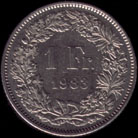 |
| 1 Swiss franc 1983 | |
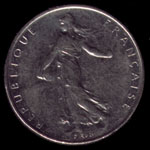 |
 |
| 1 French franc 1991 | |
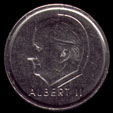 |
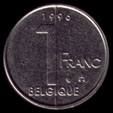 |
| 1 Belgian franc 1996 | |
 |
 |
| 1 Luxembourg franc 1990 | |
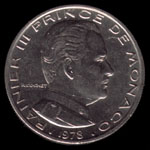 |
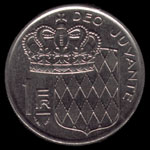 |
| 1 Monegasque franc 1978 | |
The franc is the name of several currency units, most notably the French franc, the currency of France until it adopted the euro in 1999 (by law, 2002 de facto), and the Swiss franc, still a major world currency today due to the prominence of Swiss financial institutions. The name is said to derive from the Latin inscription francorum rex ("King of the Franks") on early French coins, or from the French franc, meaning "free" (and "frank").
The countries that use francs include Switzerland, Liechtenstein, and most of the Francophone countries of Africa. Before the introduction of the euro, francs were also used in France, Belgium and Luxembourg, while Andorra and Monaco accepted the French franc as legal tender (Monegasque franc). The Franc was also used within the French Empire's colonies, including Algeria and Cambodia. The franc is sometimes italianised or hispanicised as the Franco, for instance in Luccan Franco.
One franc is typically divided into 100 centimes. The French franc symbol was an F with a line through it (₣).
Contents |
Origins
The franc was originally a French gold coin of 3.87 g minted in 1360 on the occasion of the release of King John II ("the good"), held by the English since his capture at the Battle of Poitiers four years earlier. It was equivalent to one livre tournois (Tours pound).
French franc
The French franc was the national currency of France from 1360 until 1641 and again from 1795 until 1999 (franc coins and notes were legal tender until 2002). Though abolished as a legal coin by Louis XIII in 1641 in favor of the gold louis and silver écu, the term franc continued to be used in common parlance for the livre tournois. The franc was also minted for many of the former French colonies, such as Morocco, Algeria, French West Africa, and others. Today, after independence, many of these countries continue to use the franc as their standard denomination.
The value of the French franc was locked to the euro at 1 euro = 6.55957 FRF on 1998-12-31, and after the introduction of the euro notes and coins, ceased to be legal tender after 2002-02-28 (although still exchangeable at banks).
CFA and CFP francs
Fourteen African countries use the franc CFA (in west Africa, Communauté financière africaine; in equatorial Africa, Coopération financière en Afrique centrale), originally (1945) worth 1.7 French francs and then from 1948, 2 francs (from 1960: 0.02 new franc) but after January 1994 worth only 0.01 French franc. Therefore, from January 1999, 1 CFA franc is equivalent to €0.00152449.
A separate (franc CFP) circulates in France's Pacific territories, worth €0.0084 (formerly 0.055 French franc).
Comorian franc
In 1981, The Comoros established an arrangement with the French government similar to that of the CFA franc. Originally, 50 Comorian francs were worth 1 French franc. In January 1994, the rate was changed to 75 Comorian francs to the French franc. Since 1999, the currency has been pegged to the euro.
Belgian franc and Luxembourg franc
The conquest of most of western Europe by Revolutionary and Napoleonic France led to the franc's wide circulation. Following independence from the Kingdom of the Netherlands, the new Kingdom of Belgium in 1832 adopted its own Belgian franc, equivalent to the French one, followed by Luxembourg adopting the Luxembourg franc in 1848 and Switzerland in 1850. Newly unified Italy adopted the lira on a similar basis in 1862.
In 1865, France, Belgium, Switzerland and Italy created the Latin Monetary Union (to be joined by Greece in 1868): each would possess a national currency unit (franc, lira, drachma) worth 4.5 g of silver or 0.290 322 g of gold (fine), all freely exchangeable at a rate of 1:1. In the 1870s the gold value was made the fixed standard, a situation which was to continue until 1914.
In 1926 Belgium as well as France experienced depreciation and an abrupt collapse of confidence, leading to the introduction of a new gold currency for international transactions, the belga of 5 francs, and the country's withdrawal from the monetary union, which ceased to exist at the end of the year. The 1921 monetary union of Belgium and Luxembourg survived, however, forming the basis for full economic union in 1932.
Like the French franc, the Belgian/Luxemburgese franc ceased to exist in January 1, 1999, when it became fixed at 1 EUR= 40.3399 BEF/LUF, thus a franc was worth €0.024789. Old franc coins and notes lost their legal tender status in February 28, 2002.
1 Luxembourg franc was equal to 1 Belgian franc. Belgian francs were legal tender inside Luxembourg, and Luxembourg francs were legal tender in Belgium.
The equivalent name of the Belgian franc in Dutch, Belgium's other official language, was "Belgische Frank."

Swiss franc and Liechtenstein frank
The Swiss franc (ISO code: CHF or 756), which appreciated significantly against the new European currency from April to September 2000, remains one of the world's strongest currencies, worth today around two-thirds of a euro. The Swiss franc is used in Switzerland and in Liechtenstein. Liechtenstein retains the ability to mint its own currency, the Liechtenstein frank, which it does from time to time for commemorative or emergency purposes.
The name of the country "Swiss Confederation" is found on some of the coins in Latin (Confoederatio Helvetica), as Switzerland has four official languages, all of which are used on the notes. The denomination is abbreviated "Fr" on the coins which is the abbreviation in all four languages.
Congolese franc
The Congolese franc is used in the Democratic Republic of Congo. Suppressed in 1967 by Mobutu, it was re-established in 1998 by Laurent Desire Kabila when he came to power.
Burundian franc
The Burundian franc is used in Burundi.
Rwandan franc
The Rwandan franc is used in Rwanda.
Djiboutian franc
The Djiboutian franc is used in Djibouti. Pegged to the US dollar since 1973.
Guinean franc
The Guinean franc is used in Guinea. Suppressed in 1972 by dictator Sékou Touré, re-established in 1986 by his successor Lansana Conté.
Malagasy franc
The Malagasy franc was replaced by the Malagasy ariary on January 1, 2005. This controversial decision was made by President Marc Ravalomanana.
See also
- Cape Verdean escudo
- Latin Monetary Union
- The Latverian Franc is the currency of the fictional country of Latveria.
- Special settlement currencies
- UIC franc
- gold franc
- Livre tournois (French pound)
- Roman currency
- New Hebrides franc
External links
|
||||||||||||||